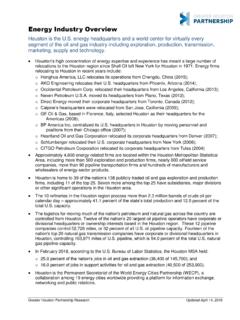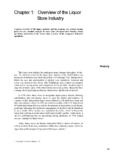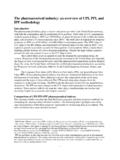Transcription of Mineral Sands: An Overview of the Industry - Iluka …
1 Mineral Sands: An Overview of the Industry Greg Jones1 ABSTRACT Mineral sands are different to most commodities, however they share similarities with other commodity types, such as the importance of quality constraints of iron ore and coal or the importance of physical properties of diamonds. The Mineral sands Industry consists of two principal product streams; titanium dioxide minerals in the form of rutile, ilmenite and leucoxene; and zircon. The principal valuable heavy minerals (VHM) include ilmenite, leucoxene, rutile and zircon. Variations of other titanium minerals occur between the end members of ilmenite and rutile, including pseudo rutile and anatase.
2 Most Mineral sands deposits are found in unconsolidated fossil shorelines several hundreds of metres to tens of kilometres and occasionally hundreds of kilometres inland from the present coastline. Mineral sands orebodies essentially fall into two categories based on the mode of deposition: alluvial or aeolian. Alluvial deposits are further split into marine beach placers (or strandlines) and lacustrine heavy Mineral (HM) accumulations. Exploration for Mineral sands involves the positive identification of key criteria leading to the focus of exploratory surface sampling, augering and drilling. Assaying is primarily focused around determining the percentage of HM contained within a given sample.
3 Other results of interest include clay fines, sand and oversize. Metallurgical/mineralogical assessment is often undertaken by via laboratory scale bench tests that replicate the wet concentration and dry mill processing routes. The most critical component in resource assessment for Mineral sands is about quantifying HM grade, then mineralogical assemblage and then quality of those Mineral species. This will determine whether a Mineral sand final product is marketable or not. Mining of Mineral sands is conducted either wet or dry. Wet methods are generally preferred for large tonnage, unconsolidated and low clay orebodies. Where ground conditions are hard and orebodies are small, high grade and discontinuous, dry mining techniques are generally employed.
4 Concentration of Mineral sands from the primary ore is carried out in two sections; wet, utilising sizing and gravity differentiation between HM, VHM, clay and quartz, and dry, exploiting the magnetic, electrostatic and to a lesser extent SG properties of the minerals of interest. Mineral sands exploration, mining and processing faces the same operating challenges as the rest of the resource sector. Added to this are the issues that are unique to Mineral sands and to which the Industry devotes considerable resources to developing solutions. INTRODUCTION Mineral sands are different to most commodities, however they share similarities with other commodity types, such as the importance of quality constraints of iron ore and coal or the importance of physical properties of say diamonds.
5 The term " Mineral sands" normally refers to concentrations of heavy minerals (HM) in an alluvial (old beach or river system) environment. Occasionally these deposits are referred to as "beach sands". However Mineral sands are also found in large aeolian sand systems or dunal sands . The exploration, development, mining and processing of Mineral sands is atypical within the resource sector, because at virtually every stage it is possible to visually estimate the grade and composition of the HM and valuable heavy Mineral (VHM). Even the rehabilitation of Mineral sands mining is unique in an Industry where rehabilitation of pit voids and stockpiles is now accepted good practice.
6 Part of the operating license for Mineral sands mining is to complete the backfill and rehabilitation back to a pre-mining land usage, or an alternative usage provided for in landholder agreements. 1 Greg Jones, Manager Development Geology, Iluka Resources Limited, Jenkin Rd, Capel WA 6271 E-mail Overview : TITANIUM AND ZIRCON Mineral sands represents less than one per cent of the value of the global resources sector. The Mineral sands Industry consists of two principal product streams: Titanium dioxide minerals in the form of rutile, ilmenite and leucoxene. Ilmenite is also used to manufacture titanium slag and synthetic rutile products; and Zircon.
7 Titanium Dioxide Titanium dioxide minerals are used mainly as feedstock for the world s titanium dioxide (TiO2) pigment Industry . As a pure white, highly refractive and ultraviolet light absorbing product, titanium dioxide pigment is commonly used in architectural and automotive paints, plastics, paper, textiles and inks. Titanium dioxide feedstock is also used in the manufacture of welding electrodes. Titanium minerals are non-toxic, non-fibrogenic and biologically inert and they can be used safely in foodstuffs, pharmaceuticals and cosmetics ( Iluka , 2008 and TZMI, 2008). Titanium feedstocks supply different markets however world demand for ilmenite, leucoxene and rutile is determined by the demand for titanium oxide pigment.
8 The pure white pigment is used as an opacifier in paints, plastics and paper, accounting for around 93 per cent of global titanium feedstock consumption (Figure 1) (TZMI, 2008; Iluka , 2008). Titanium dioxide pigment is produced by two alternative process routes: the chloride and sulphate processes. Figure 1: Breakdown of titanium dioxide feedstock markets by end-use sector, 2006 (source TZMI and Iluka ). Rutile, synthetic rutile and titanium slag can be used to produce titanium metal. Due to the combination of strength and lightness of titanium metal, it is used for advanced engineering applications, including architectural coatings, the aerospace and defence industries as well as a range of other applications, including sporting equipment and jewellery.
9 Titanium metal is also used in desalination plants and corrosive chemical industries and its non-reactive properties make titanium metal one of the few materials that can be used in the human body for hip replacements and heart pacemakers. Zircon Zircon is the other major product of the Mineral sands Industry and is a co-product of titanium Mineral production. In most projects zircon is only a minor by-product and only rarely would zircon be considered the principal product ( Iluka s Jacinth-Ambrosia project), with titanium minerals as co-products. An increase in the importance of zircon has resulted from increased demand and the flow on increase in zircon prices in recent years.
10 This is in addition to the discovery of higher grade zircon provinces (TZMI, 2008). The most important application for zircon is in the ceramics Industry in the production of opacifiers used in surface glazes and pigments. Prior to the 1980s refractory applications were the most common use of zircon, used to make refractory bricks and shapes for use in steel and glass industries. Limited supplies, and high prices of zircon during the late 1980s, forced steelmakers to switch to alternative refractory materials. The significant market share in this application has now been lost, as these alternatives are now preferred for technical reasons (TZMI, 2008).





